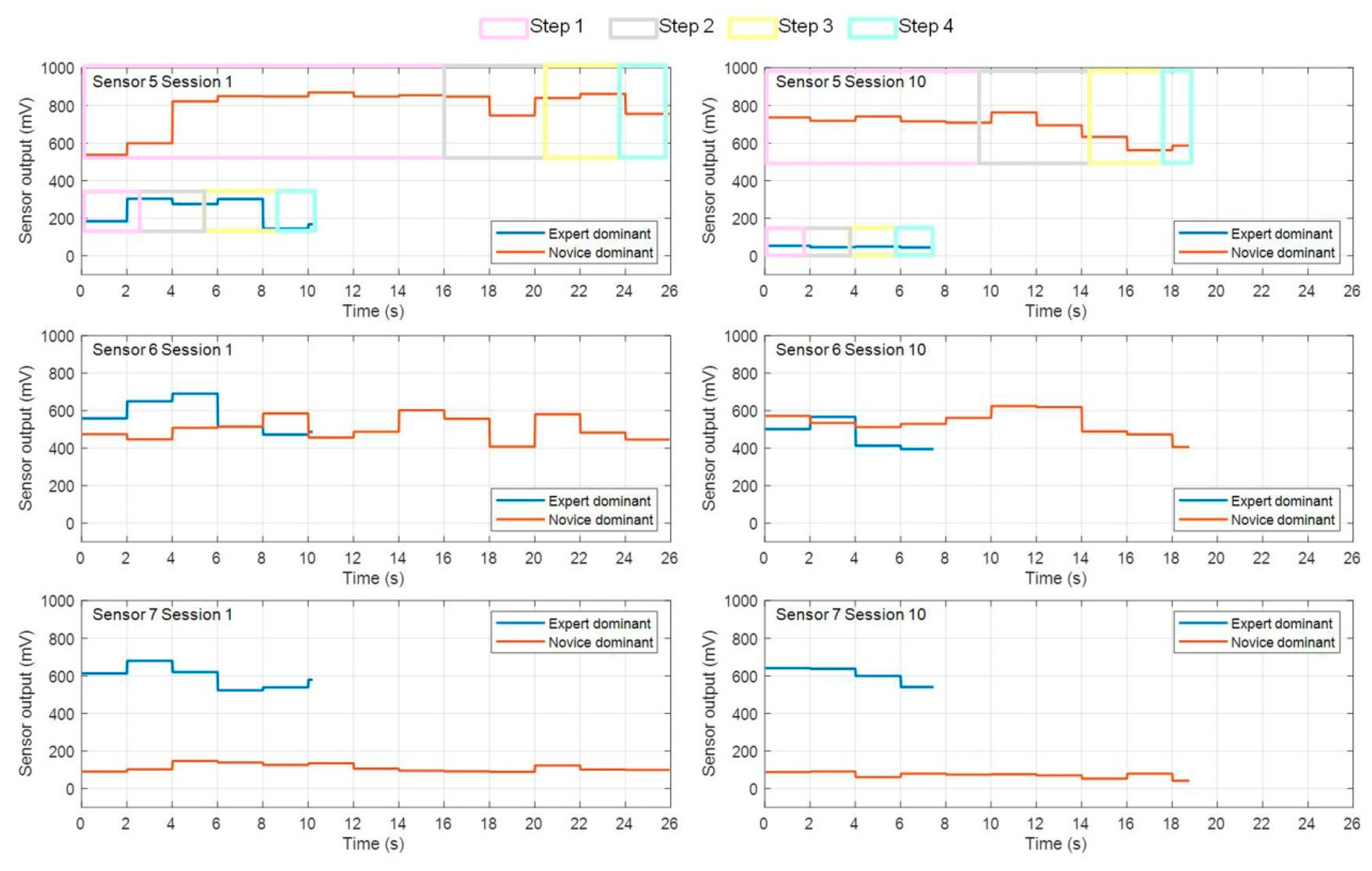Wearable Wireless Biosensors for Spatiotemporal Grip Force Profiling in Real Time †
Abstract
:1. Introduction
- Activate and move tool towards object location; requires movement ahead in depth along a virtual z-axis in 2D image plane;
- Open and close tool-tip grippers to grasp and lift object;
- Move tool with object to target location; requires lateral movement along x-axis of 2D image plane;
- Open tool-tip grippers to drop object in box.
2. Materials and Methods
2.1. Slave Robotic System
2.2. Master/Slave Control
2.3. Sensor Glove Design
2.3.1. Hardware
2.3.2. Software
3. Results
4. Discussion
Author Contributions
Funding
Acknowledgments
Conflicts of Interest
References
- ABatmaz, A.U.; Falek AMZorn, L.; Nageotte, F.; Zanne, P.; de Mathelin, M.; Dresp-Langley, B. Novice and expert behavior while using a robot controlled surgery system. In Proceedings of the 2017 13th IASTED International Conference on Biomedical Engineering (BioMed2017), Innsbruck, Austria, 21 February 2017; pp. 94–99. [Google Scholar]
- de Mathelin, M.; Nageotte, F.; Zanne, P.; Dresp-Langley, B. Sensors for Expert Grip Force Profiling: Towards Benchmarking Manual Control of a Robotic Device for Surgical Tool Movements. Sensors (Basel) 2019, 19, 4575. [Google Scholar] [CrossRef] [PubMed]
- Zatsiorsky, V.M.; Latash, M.L. Multifinger prehension: An overview. J. Mot. Behav. 2008, 40, 446–476. [Google Scholar] [CrossRef] [PubMed]
- Kinoshita, H.; Murase, T.; Bandou, T. Grip posture and forces during holding cylindrical objects with circular grips. Ergonomics 1996, 39, 1163–1176. [Google Scholar] [CrossRef] [PubMed]
- Kinoshita, H.; Kawai, S.; Ikuta, K. Contributions and co-ordination of individual fingers in multiple finger prehension. Ergonomics 1995, 38, 1212–1230. [Google Scholar] [CrossRef] [PubMed]
- Latash, M.L.; Zatsiorsky, V.M. Multi-finger prehension: Control of a redundant mechanical system. Adv. Exp. Med. Biol. 2009, 629, 597–618. [Google Scholar] [PubMed]
- Batmaz, A.U.; de Mathelin, M.; Dresp-Langley, B. Getting nowhere fast: Trade-off between speed and precision in training to execute image-guided hand-tool movements. BMC Psychol. 2016, 4, 1535. [Google Scholar] [CrossRef] [PubMed]
- Batmaz, A.U.; de Mathelin, M.; Dresp-Langley, B. Seeing virtual while acting real: Visual display and strategy effects on the time and precision of eye-hand coordination. PLoS ONE 2017, 12, e0183789. [Google Scholar] [CrossRef]
- Batmaz, A.U.; de Mathelin, M.; Dresp-Langley, B. Effects of 2D and 3D image views on hand movement trajectories in the surgeon’s peri-personal space in a computer controlled simulator environment. Cogent Med. 2018, 5, 1426232. [Google Scholar] [CrossRef]
- Dresp-Langley, B. Towards Expert-Based Speed–Precision Control in Early Simulator Training for Novice Surgeons. Information 2018, 9, 316. [Google Scholar] [CrossRef]
- Abiri, A.; Pensa, J.; Tao, A.; Ma, J.; Juo, Y.Y.; Askari, S.J.; Bisley, J.; Rosen, J.; Dutson, E.P.; Grundfest, W.S. Multi-Modal Haptic Feedback for Grip Force Reduction in Robotic Surgery. Sci. Rep. 2019, 9, 5016. [Google Scholar] [CrossRef] [PubMed]
- Johansson, R.S.; Cole, K.J. Sensory-motor coordination during grasping and manipulative actions. Curr. Opin. Neurobiol. 1992, 2, 815–823. [Google Scholar] [CrossRef]
- Dresp, B. Local brightness mechanisms sketch out surfaces but do not fill them in: Psychophysical evidence in the Kanizsa square. Percept Psychophys. 1992, 52, 562–570. [Google Scholar] [CrossRef] [PubMed]
- Dresp-Langley, B.; Monfouga, M. Combining Visual Contrast Information with Sound Can Produce Faster Decisions. Information 2019, 10, 346. [Google Scholar] [CrossRef]


| Sensor | Finger | Anatomical Reference |
|---|---|---|
| S5 | Middle | Middle Phalanx |
| S6 | Ring | Middle Phalanx |
| S7 | Pinky | Middle Phalanx |
Publisher’s Note: MDPI stays neutral with regard to jurisdictional claims in published maps and institutional affiliations. |
© 2020 by the authors. Licensee MDPI, Basel, Switzerland. This article is an open access article distributed under the terms and conditions of the Creative Commons Attribution (CC BY) license (https://creativecommons.org/licenses/by/4.0/).
Share and Cite
Liu, R.; Nageotte, F.; Zanne, P.; Mathelin, M.d.; Dresp-Langley, B. Wearable Wireless Biosensors for Spatiotemporal Grip Force Profiling in Real Time. Eng. Proc. 2020, 2, 45. https://doi.org/10.3390/ecsa-7-08252
Liu R, Nageotte F, Zanne P, Mathelin Md, Dresp-Langley B. Wearable Wireless Biosensors for Spatiotemporal Grip Force Profiling in Real Time. Engineering Proceedings. 2020; 2(1):45. https://doi.org/10.3390/ecsa-7-08252
Chicago/Turabian StyleLiu, Rongrong, Florent Nageotte, Philippe Zanne, Michel de Mathelin, and Birgitta Dresp-Langley. 2020. "Wearable Wireless Biosensors for Spatiotemporal Grip Force Profiling in Real Time" Engineering Proceedings 2, no. 1: 45. https://doi.org/10.3390/ecsa-7-08252







